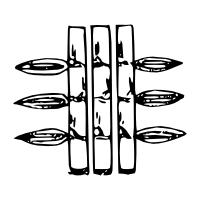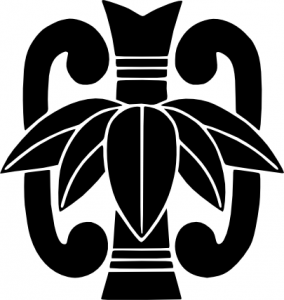Recreational research into Feudal Japan
Posts tagged bamboo
Mon of the Week: Three Bamboo Poles
Sep 6th (a Butsumetsu (仏滅))
Bamboo groves are commonplace in Japan, and bamboo has long been used as a construction material and for uses such as piping (due to its hollowness) and can easily be sharpened into a spear. Here we have a different take on bamboo found in the collection of provincial mon.(KJ:7) Unlike the more popular depiction of bamboo leaves in clumps, as we saw in our recent fan with bamboo, this mon has single leaves protruding sharply at right angles from the trunks. This gives the leaves a harsher, almost spearhead-like appearance. With the minimal information given by the source, any motivation behind this depiction would be pure speculation; suffice it to say that while variations of bamboo have always been popular in Japanese heraldry and design, this particular version did not catch on.
Mon of the Week: Fan with Bamboo
May 23rd (a Senshō (先勝))
This week we look at another 15th-century rural samurai mon.(KJ:7) It shows what appears to be a nonfolding paper fan decorated with a bar, possibly the character for “one”, with a bamboo stem with leaves serving as the handle.
This is similar to a mon in use today, depicting a T’ang dynasty fan (唐団扇/tō uchiwa) with bamboo grass (笹/sasa).(IEJFC:39)
The shape of the fan is somewhat different in the more recent mon; my interpretation is that the design became more stylized as mon became standardized in the Edo period. This also shows how earlier mon had more flexibility in combining multiple unrelated elements in ways later mon would not. In addition, the bamboo stem in the modern one has become more stylized, somewhere between an actual bamboo stem and a fan rod. However, these two mon also show the consistency of mon in different eras, even as the ways mon were created, assigned, and used changed.
ADDED INFO:
A similar fan mon with a simplified, filled design and a simple post instead of the bamboo detail was used by Okudaira Nobumasa in the siege of Nagashino Castle in 1575.(SH:D5,59)



